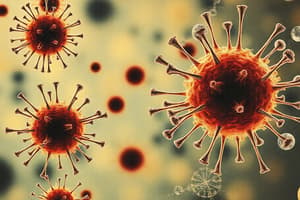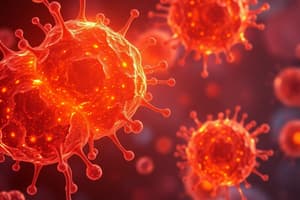Podcast
Questions and Answers
Why do different pathogens activate different types of T-helper cells?
Why do different pathogens activate different types of T-helper cells?
- To ensure that the adaptive immune response is tailored to the specific characteristics of each pathogen. (correct)
- To reduce the overall energy expenditure of the immune system during an infection.
- To prevent the immune system from overreacting to minor infections.
- To minimize the activation of B cells, which can lead to autoimmune disorders.
Which statement accurately describes the relationship between T-helper cells and pathogens?
Which statement accurately describes the relationship between T-helper cells and pathogens?
- A single pathogen can only activate one specific type of T-helper cell.
- Each type of pathogen activates all three main types of T-helper cells equally.
- Different pathogens activate distinct T-helper cells to initiate specific aspects of the adaptive immune response. (correct)
- T-helper cells directly kill pathogens through the release of cytotoxic granules.
In cell-mediated immunity, which T-helper cell is primarily involved?
In cell-mediated immunity, which T-helper cell is primarily involved?
- Th17
- Treg
- Th2
- Th1 (correct)
Through what mechanism does Th1 activate macrophages?
Through what mechanism does Th1 activate macrophages?
Which interleukin is responsible for the stimulation of CD8+ T cells by Th1 cells?
Which interleukin is responsible for the stimulation of CD8+ T cells by Th1 cells?
What is the primary role of Th2 cells in humoral immunity?
What is the primary role of Th2 cells in humoral immunity?
Which antibodies are stimulated by Th2 cells?
Which antibodies are stimulated by Th2 cells?
What role do eosinophils play in the context of Th2 activation?
What role do eosinophils play in the context of Th2 activation?
What is the major function of Th17 cells within the immune response?
What is the major function of Th17 cells within the immune response?
Which type of infection would most likely trigger a Th17 response?
Which type of infection would most likely trigger a Th17 response?
What is the role of IgM antibodies in the initial stages of an immune response?
What is the role of IgM antibodies in the initial stages of an immune response?
What stimulates B cells to produce IgM antibodies?
What stimulates B cells to produce IgM antibodies?
Why is IgG essential for clearing extracellular pathogens?
Why is IgG essential for clearing extracellular pathogens?
What role does IFN-$\gamma$ play in the switch from IgM to IgG production?
What role does IFN-$\gamma$ play in the switch from IgM to IgG production?
What is the significance of IgG in opsonization?
What is the significance of IgG in opsonization?
What is the relationship between Th1 cells and IgG antibody production?
What is the relationship between Th1 cells and IgG antibody production?
Upon encountering an extracellular pathogen, which T-helper cell is activated to initiate response?
Upon encountering an extracellular pathogen, which T-helper cell is activated to initiate response?
Which of the following functions are carried out by the activated Th17 cell?
Which of the following functions are carried out by the activated Th17 cell?
In the context of Th17 activation, what specific action directly contributes to strengthening the body's defense against infection?
In the context of Th17 activation, what specific action directly contributes to strengthening the body's defense against infection?
What is the significance of IFN-$\gamma$ released by Th1 activated B cells?
What is the significance of IFN-$\gamma$ released by Th1 activated B cells?
Flashcards
T-helper cells' role
T-helper cells' role
T-helper cells stimulate different aspects of the adaptive immune response based on the type of pathogen encountered.
Main T-helper cell types
Main T-helper cell types
The three main types of T-helper cells are Th1, Th2, and Th17.
Th1 cell function
Th1 cell function
Involved in cell-mediated immunity, activated by viruses, intracellular bacteria and cancerous cells. Activates macrophages via INF-γ, stimulates cytotoxic T-cells via IL-2, and stimulates B cells to produce IgG antibodies.
Th2 cell function
Th2 cell function
Signup and view all the flashcards
Th17 cell function
Th17 cell function
Signup and view all the flashcards
IgM antibodies
IgM antibodies
Signup and view all the flashcards
IgG antibodies
IgG antibodies
Signup and view all the flashcards
Study Notes
Helper T Cells
- Assist in stimulating different aspects of the adaptive immune response.
- Activation is dependent on the type of pathogen/allergen encountered.
- Three main types: Th1, Th2, and Th17.
- A single T-helper cell type can perform multiple functions.
- A single pathogen may activate more than one T-helper cell.
- A single T-helper cell may only have certain functions activated.
Th1
- Critical for cell-mediated immunity.
- Predominantly activated by viruses, intracellular bacteria, and cancerous cells.
- Activates macrophages (phagocytosis) via INF-γ.
- Stimulates CD8+ T cells (cytotoxic T cells) via IL-2.
- Stimulates B cells to produce IgG antibodies for opsonization, complement activation, and neutralization.
Th2
- Critical for humoral immunity, destroying pathogens using antibodies.
- Mediates immunity against parasites and allergic reactions.
- Stimulates B cells to produce IgA and IgE.
- Activates eosinophils.
- Induces mast cell degranulation.
- Increases mucus production in the gut to expel parasites.
Th17
- Recruits neutrophils and strengthens mucosal barriers.
- Active against extracellular bacterial and fungal infections.
- Recruits neutrophils.
- Strengthens epithelial barriers.
- Enhances antimicrobial protein production.
- Promotes inflammation.
Extracellular Pathogens
- Th17 is activated to combat the challenges listed to fight off the extracellular pathogen.
- IgM antibodies are produced rapidly at the start of an infection.
- IgM antibodies are the first antibodies produced in an immune response due to some pathogen antigens directly stimulating B cells ('T-independent immune response').
- IgG antibodies also need to be produced and require T-helper cells type 1 (Th1).
- IFN-γ is released by Th1-activated B cells to switch from IgM to IgG production.
- IgG is effective at opsonization, facilitating macrophage engulfment of bacteria.
- IgG is essential for the complete clearance of the extracellular pathogen.
Helper T Cell Involvement
- Multiple helper T cells can be involved in an immune response.
- Specific functions are carried out by specific helper T cells.
Studying That Suits You
Use AI to generate personalized quizzes and flashcards to suit your learning preferences.



